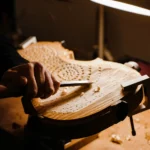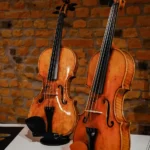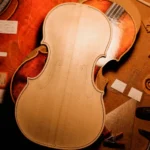Let’s Talk About Violin Materials: Accessories, Tips & Rosin
Back to BlogWhat every violinist should know about is that you can get the most out of your playing experience when you know your instrument better. We are talking about the violin’s materials: accessories, essential tips, and rosin. Some are quite necessary, some are basics, but all of them are worth knowing about!
The violin is a beautiful instrument that can bring so much life to music. Invented centuries ago, this instrument has been enlightening many people’s hearts along with musician talents. To help musicians and make the playing even better, violin accessories, like chin rests, peg shapers, and so many others, have been invented. Getting to know them is crucial for a violinist. After all, knowledge is the way to improve in every area.
Here, we’ll share with you some of these materials that you need to know about:
Let’s go through the most important Violin Accessories:
Violin Pegs
There must be a set of well-functioning, well-fitted tuning pegs for a violin to be played well. Violin pegs keep your strings in place by fitting into holes called pegboxes. A pegbox is located at the end of the fingerboard and looks like a box–that’s where it gets its name. There are many different kinds of pegs, each one with its own design.
Pay close attention to the peg of the A-string; if you always put too much force to put it in place, or if it is poorly adapted, the excess pressure can easily cause a rupture in the pegbox.
One way to keep tuning pegs from slipping is to position the strings as close as possible to the peg box’s cheek. By tugging on the strings, you can pull the legs inward.
Over time, the wood fibers contract and change the pegs’ circular shape to an oval shape. When the pegs are oval, they no longer fit perfectly into the hole in the pegbox, making it difficult to turn – that’s a good reason why tuning can be hard sometimes. So lubricating it with graphite will facilitate this movement for you.
The strings are an essential topic for you, violinists!
A set of strings can make your tone fit a track better. You can get different brightness, tonal quality, and tension depending on your choice.
Also, you need to change the strings someday, as they don’t last forever. Violinists tend to change the strings on their instruments about once every 300 hours of playing. In other words, if you’re a student, you could probably get away with string changes every three to six months. Professional violinists may change their strings more frequently, depending on their time spent practicing.
We recommend starting by understanding the kind of sound you dream your instrument to have and then start searching for it. We have a whole blog dedicated to the topic. Check it out!
Pay close attention to the Rosin
The rosin has a sticky quality when you rub it. It’s drawn in the same way maple syrup is collected without causing any harm to the tree. It smells a bit like pine and has a glassy, orange look.
Its function is to create friction, allowing the bow to grip the strings and make them vibrate more clearly.
It should be treated carefully, as it cracks very easily.
We advise you to store it in a room, just like your violin, away from the temperature fluctuations.
No matter what kind of rosin you choose it is important to know what the right amount to use is. So, take note:
Rosin should only be used when deemed completely necessary. By doing that, you will avoid a build-up of rosin across the hairs of the bow. As rosin’s function is to create friction, too much will affect the sound quality and create an overly aggressive and dirty sound.
Chinrest
The chin rest is a cushioned pad attached to the violin that allows a musician to comfortably and accurately place his or her chin on the instrument during a performance.
The chin rest was invented to relieve the strain on the chin caused by long hours of playing the violin.
Choosing a violin chinrest turns out to be a very personal choice, and you should choose the chinrest that best suits your chin’s shape. You should also consider the chinrest’s height—it’s important that the chinrest fits with your neck length. This criteria should come first, and then you can adjust the positioning according to what makes you feel most comfortable.
Violin Bridge
The bridge helps transmit the vibrations created by the bow through the soundboard and that is what we hear as violin sounds. The pressure of the strings held in place by the bridge allows the instrument to be played during a performance.
The larger of the two surfaces is called the top, where the bridge rests. It’s a resonant area that helps amplify sound. Additionally, the bridge acts as an acoustic filter, suppressing specific undesired frequencies.
The Tailpiece
The correct tailpiece may improve a violin’s sound. There are a wide range of tailpieces on the market, and the best one will only depend on you and your instrument’s needs. It is important to choose one that is adapted to the instrument and responds quickly and easily to what the musician wants. The suitable tailpiece can also be used to improve resonance and make your violin sounds better.
The humidifiers: Protect your instrument from the weather fluctuations
The humidity and temperature level affect your instrument and can cause damage without proper care. Protect your violin and bow when they’re not in use. Humidifiers help stabilize the relative humidity around your violin and bow. You can set them next to your case or wherever you store your violin. For an instrument to be at top conditions, you should keep relative humidity levels at 50-60%.
Violin Bags & Cases
They are a must! Besides protecting your instrument from scratches, they also help protect it from weather fluctuations. There are different cases and bags on the market that you can choose from. These high-quality carriers protect your violin and its accessories while you travel. You can find some cases that have compartments or pockets, making it easier to store your items.









